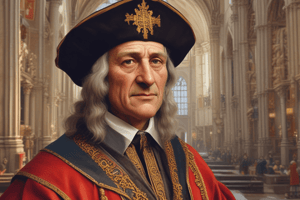Podcast
Questions and Answers
What basic question is asked in the humanities?
What basic question is asked in the humanities?
- How can I change the world?
- What is the purpose of life?
- Who am I? (correct)
- What is the nature of reality?
What does the sciences deal with?
What does the sciences deal with?
- Natural phenomena (correct)
- Cultural phenomena
- Human phenomena
- Social phenomena
Who is the philosopher known for the quote 'Know thyself'?
Who is the philosopher known for the quote 'Know thyself'?
Socrates
The humanities deal with the natural and physical phenomena.
The humanities deal with the natural and physical phenomena.
The artist creates art for the ______.
The artist creates art for the ______.
What is the reflexive method in the humanities?
What is the reflexive method in the humanities?
Which of the following is NOT a field of learning in the humanities?
Which of the following is NOT a field of learning in the humanities?
Study Notes
Lecture 1: Art as a Humanistic Discipline
-
Distinguishing Humanities and Sciences: Humanities deal with human phenomena; sciences deal with natural and physical phenomena. Humanities employ a reflexive method where the subject and object of study are intertwined (subject-knower = object-known), while sciences use a subject-object approach (scientist learns about things in the world).
-
The Humanities in Western Civilization: The lecture surveys the historical role and significance of the humanities within Western culture.
-
Humanities and Filipino Personhood (Pagkatao): Explores the connection between Western concepts of humanities and the Filipino understanding of self ("pagkatao").
-
History of Art as a Humanistic Discipline: Examines art's historical development as a branch of humanistic study. Erwin Panofsky's (1955) "The History of Art as a Humanistic Discipline" is a key reading.
-
Comparing Western and Filipino Concepts of Art: The lecture compares and contrasts how art is perceived and understood in Western thought and Filipino thought.
-
Discovering Filipino Identity Through the Arts: Focuses on understanding Filipino identity through artistic expressions.
-
Key Readings: Includes Erwin Panofsky's "Meaning in the Visual Arts" (1955), Prospero Covar's "Kaalamang Bayang Dalumat ng Pagkataong Pilipino" (1992), and Felipe De Leon's "Defining the Filipino Through the Arts" (2015).
-
Key Videos: Explores distinctions between art and craft (Laura Morelli, 2014), the work of Damian Domingo (Xiao Time, 2014), and iconic indigenous symbols (ANC-NCCA, 2015).
-
Basic Question in Humanities: The core question explored is "Who am I?"
-
Socrates' Influence: Socrates' (469-399 BC) "Know thyself" is highlighted as a foundational concept in humanities' methodology.
-
Paradigm for Learning: The lecture contrasts the subject-object paradigm in science with the reflexive paradigm in humanities.
Fields of Learning:
- Divided into Humanities and Sciences.
- Humanities include Language, History, Philosophy, and Art. (Art creation, art appreciation, artist practice, and spectator practice are also discussed)
Studying That Suits You
Use AI to generate personalized quizzes and flashcards to suit your learning preferences.
Related Documents
Description
This quiz covers key concepts from Lecture 1 on Art as a Humanistic Discipline. Explore the distinctions between humanities and sciences, the historical significance of the humanities in Western civilization, and the interplay between Western and Filipino concepts of self and art. Delve into Erwin Panofsky's perspectives on art history and its humanistic relevance.




